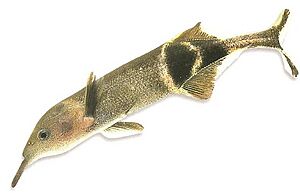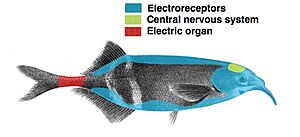Peters's elephantnose fish facts for kids
Quick facts for kids Peters's elephantnose fish |
|
|---|---|
 |
|
| Elephantnose fish | |
| Conservation status | |
| Scientific classification | |
| Synonyms | |
|
The Peters's elephant-nose fish (Gnathonemus petersii) is a very special freshwater fish from Africa. It belongs to a group of fish called elephantfish. You might also hear it called the elephantnose fish or long-nosed elephant fish. Its Latin name, petersii, probably honors a German scientist named Wilhelm Peters. This fish has an amazing ability: it uses electrolocation to find food. It also has one of the largest brain-to-body oxygen use ratios of any animal with a backbone!
Contents
About the Elephantnose Fish
The Peters's elephantnose fish lives in the rivers of West and Central Africa. You can find it in places like the lower Niger River basin. It likes muddy rivers and pools that move slowly. It also likes places with lots of hiding spots, like sunken branches.
This fish is dark brown or black. It's flat on its sides and usually grows to about 23-25 centimeters (about 9-10 inches) long. It has a forked tail fin. Its most noticeable feature is a trunk-like part on its head. This isn't a real nose, but a very sensitive extension of its mouth. The fish uses this special organ to protect itself, talk to other fish, find its way, and search for worms and insects to eat.
This special "nose" is covered in tiny sensors called electroreceptors. Many other parts of its body also have these sensors. The elephantnose fish creates a weak electric field around itself. It does this using special cells called electrocytes, which used to be muscle cells. This electric field helps the fish find food, navigate in dark or cloudy water, and even find a mate. Peters's elephantnose fish can live for about 6 to 10 years.
How It Uses Electricity

The elephantnose fish is a weakly electric fish. This means it can sense moving prey and worms hidden in the mud. It does this by sending out short electric pulses from an electric organ in its tail. The electroreceptors all over its body are super sensitive. They can detect how the electric field changes when it hits objects that conduct or block electricity. You can even hear these weak electric fields! If you put two electrodes in a fish tank with an elephantnose fish and connect them to an audio amplifier, you can hear the fish's electric pulses.
Keeping Elephantnose Fish as Pets
The Peters's elephantnose fish is a popular pet fish. You can often find it in aquarium stores in the United States. When kept in an aquarium, these fish are shy. They prefer a tank with lots of plants and dim lighting. A tank larger than 200 liters (about 50 gallons) is best. It's also good to add a pipe or a hollow log for them to hide in. The bottom of the tank should have soft, sandy sand. This allows the fish to dig through it with its delicate mouth.
These fish eat small worms, like bloodworms, and water insects such as mosquito larvae. They will also eat frozen or flake food. Elephantnose fish like water that is not too hard, with a pH between 6.8 and 7.2. The water temperature should be between 26-28 degrees Celsius (79-82 degrees Fahrenheit).
Even though they are usually calm, elephantnose fish can sometimes be aggressive towards other types of fish. However, they can live well in a community aquarium if the tank is large enough. But they are very territorial towards other elephantnose fish. If your tank is smaller than 400 liters (about 100 gallons), it's best to keep only one.
The elephantnose fish has excellent vision in low light. Its eyes use special crystals and mirrors to help it see in dim conditions.
It's important to know that Peters's elephantnose fish have never been bred in captivity. This means all the fish you see in pet stores were caught in the wild. So, if you keep one, you need to make sure the water conditions are just right for it to stay healthy.
See also
- List of freshwater aquarium fish species
- Medjed (fish)


